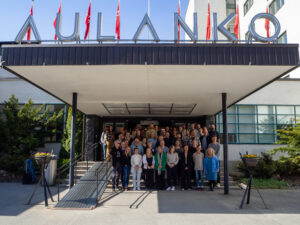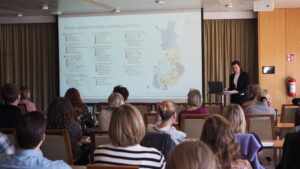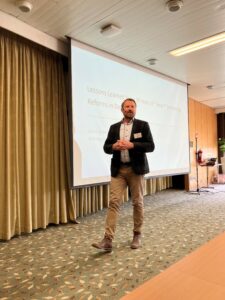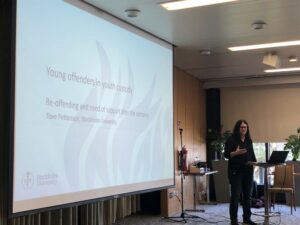By Riikka Kostiainen
The annual seminar of the Nordic Research Council for Criminology (NSfK) was held in Hämeenlinna in May. The overarching theme of the seminar was the future of punishment, and the range of perspectives on the topic was comprehensive. Dozens of presentations were mainly divided into three simultaneous working groups. The three-day seminar was attended by about 80 researchers and representatives of the judicial administration. The presentations and discussion conveyed the similarity of problems and solutions in the Nordic countries and concern about the effects of tougher criminal policy.

The opening main lecture of the seminar was given by Kaisa Tammi, Director of the Hämeenlinna Criminal Sanctions Centre, and the topic was the development of women-specific work in prisons. She talked about a study she conducted in 2020 on the situation of women prisoners and how its recommendations have been implemented in Finland.
The main findings of Tammi’s study were that women’s units operated in accordance with models developed for men, the supervision of the units was not systematic, there were many kinds of attitude problems, little was known about the needs of women prisoners, and an illusion of equality presided.
The report included recommendations on the organisation and management of women’s prison work, staff training, the establishment of women’s prisons and units for women prisoners, and the services needed by women.

‘Training has been organised for employees and management in the criminal sanctions sector. Mixed open prisons have been abandoned, women’s wards in prisons have been renovated, and new ones have been established. However, the objectives have not been fully realised. Some employees have refused training, training information in general has not yet become practice, female prisoners are a sensitive topic even in internal discussions in the field, and the male norm is still strong in prison services,’ Ms Tammi summed up.
In Ms Tammi’s view, the short-term challenges of women’s prison work include increasing trauma awareness, taking into account the needs of transgenderism and sexual minorities and, for example, identifying and helping victims of human trafficking.
Open prison focuses on rehabilitation
As an alternative, the seminar programme included a visit to Vanaja Women’s Open Prison. At the facility, Deputy Director Tuija Muurinen and Criminal Sanctions Worker Anna-Leena Suomela talked about the operations of the prison, the needs of women prisoners, and the activities of the family unit. Vanaja has 47 places of imprisonment. On weekdays, most prisoners are outside studying or working. Co-operation with the City of Hämeenlinna is intensive in organising rehabilitative activities and services. Prisoners are encouraged to take responsibility for their lives and do things independently, as well as learn self-respect. These are important issues in rehabilitation.
A family unit has also been established in connection with Vanaja Open Prison, which is a special child protection unit under the National Institute for Health and Welfare and works in close co-operation with the employees of the facility. There are ten places for prisoners and their children under 2 years old; fathers are also sometimes placed there with small children.
‘The family unit provides a safe, homelike environment. The employees are social work and health care professionals, and the work focuses on unpacking the parents’ trauma. The best results are achieved when the investment period is long enough to work on the problems. The effort also involves taking other family members into account and collaborating with many parties outside the prison. Children are often the biggest motivation for rehabilitation,’ Ms Muurinen explained.
Recidivism is studied from many perspectives
Norway is known for its low recidivism rates. Postdoctoral researcher Synnøve Nygaard Andersen from the University of Oslo talked about the challenging nature of the study. Depending on who is being investigated, what counts as a new offence and what the follow-up period is, Norway’s recidivism rate is somewhere between 9% and 53%. In general, research into recidivism simplifies criminal careers, emphasises failure rather than success, and underestimates the impact of punishment on other aspects of life, such as health – especially mental health – as well as on employment and housing. However, it is possible to conduct high-quality recidivism research in the Nordic countries because the official registers are good, and the methods of quantitative research are mastered and supported by strong qualitative exit research with regard to offences.

A report on the prevention of recidivism and the transmission of intergenerational problems was presented by Senior Researcher Åsa Norman from Karolinska Institutet. She has studied the effectiveness of the parenting support programme used in prison services in Sweden. Empirical results indicated that intervention in prison had positive impacts on the quality of the parent-child relationship and interest in committing crimes. According to Norman, promoting healthy relationships can influence criminal behaviour and reduce recidivism.
In Finland, a register study has been launched to examine the impact of a parent’s prison sentence on a child’s life. The research was presented by doctoral student Ilona Nissinen from the University of Helsinki. The first results concern the background information concerning the parents and children. Later in the study, the connection between a parent’s prison sentence and the child’s criminal behaviour will be investigated.
Professor Fred Markowitz from Northern Illinois University has studied the relationship between homelessness and crime from a community perspective in Finland. He has collected data from 261 municipalities over a period of 13 years. Although Finland has succeeded in reducing homelessness considerably, a significant number of offenders experience homelessness. Research shows that homelessness is associated with increased violent crime, property crime, and public peace violations while intoxicated. The findings suggest to Professor Markowitz that reducing homelessness is very important not only to improve the offender’s rehabilitation and living conditions, but also to increase the safety of the local community.
New penalties developed specifically to tackle juvenile delinquency
Many presentations emphasised the importance of studying the effectiveness of criminal policy reforms. Professor Lars Højsgaard Andersen from the Rockwool Foundation studied the impact of the introduction of electronic surveillance in Denmark in 2000. According to Professor Andersen, such “smart” punishments are cheaper and less intrusive in the life of the convicted person and his family than imprisonment, but are nevertheless hefty punishments. Electronic surveillance has proven to be an effective but at the same time unfair punishment in preventing recidivism. Evidently the same reasons that allow the convicted person to be suitable for punishment contribute to coping with life even after sentencing. Unfit people are required to serve their sentences in prison. However, Professor Andersen pointed out that imprisonment also has its advantages, and rehabilitation is possible.

In 2019, Denmark introduced a policy reform introducing court-like procedures for minors: Cases of young people aged 10 to 17 who have committed violent and other serious crimes are heard by juvenile crime boards, and a new juvenile sanction “youth service” was created. The reform has received strong cross-party support and aims to tackle serious crimes committed by young people as well as prevent young people from drifting into criminal careers. Before the reform, child welfare measures were used to react to offences committed by those aged 10–14, whilst offences committed by those aged 15–17 could also result in either conditional or unconditional incarceration. Senior Researcher Britt Østergaard Larsen from the Danish Centre for Social Research presented the impacts of the reform in the light of statistical data. In 2019–2021, a total of 2,555 cases ended up being handled by juvenile crime boards. The number of those aged 10–14 in the juvenile delinquency system has been substantial, about 400 cases per year, which is almost as high as that of those aged 15–17. On average, 600 cases per year were assigned to youth services.
The new youth service with its supervisory functions and interventions is a highly intensive sanction and binds a lot of young people’s and parents’ time. The municipalities are forced to organise services for young people and families that may have been difficult to obtain before the crime. Researcher Theresa Dyrvig Henriksen shared the results of interviews with children who participated in the hearings of the mandatory Criminal Offences Board. The children felt that the system was complex and that their own possibility of influence was non-existent. Youth service was seen as punishment rather than support.

Professor Tove Pettersson from Stockholm University spoke about her research on Swedish institutions for offenders aged 15 to 17. Between 1999 and 2017, 70% of those placed in the facility had previous convictions. Sentences imposed to these institutions were mainly for serious violent crimes. Two years after sentencing, 60% of the young people had committed a new offence, but over time crime decreased. Those sentenced to a juvenile institution would need considerable support both during and after their sentence. The young people interviewed themselves estimated that the most important thing in avoiding crime would be to move elsewhere and leave their old friends, whilst education and employment were also regarded as important. The desire to stop committing crimes was great immediately after sentencing, and this time frame must be utilised. Professor Petterson stressed the need to see that these children are in danger rather than being dangerous children.
The central importance of pre-trial detention must be seen in criminal policy
Much discussion was sparked by two interesting studies. The first was a study by Emelie Lönnqvist, a doctoral candidate at Stockholm University, on the use of pre-trial detention in the Nordic countries. During pre-trial detention, prisoners’ rights are limited and participation in activities is not possible due to separation requirements, for example. From 1983 onwards, the use of pre-trial detention increased in all other countries with the initial exception of Finland. Since 2010, the trend has been declining in Norway, stable in Finland, and rising again in Denmark and Sweden after a short decline. Finland has the lowest use of pre-trial detention and Denmark the highest. However, there are major differences in its length: although Finland has the lowest number of people in pre-trial detention, it has been clearly longer than in other countries. An increasing proportion of the sentence is served in pre-trial detention. Ms Lönnqvist stressed the importance of keeping pre-trial detention as short as possible and taking better account of fundamental rights.

Along with her colleagues, Marina Hiller Foshaugen, a doctoral student at the University of Oslo, conducted a study on Google geotags estimates concerning Norwegian prisons between 2017 and 2021 (total 214). Most of the reviews reflected stereotypes about prison life such as “A five-star hotel with no escape”, “A nice break, free accommodation and food”. There were also seemingly genuine comments from former inmates and staff, and they were usually critiques of the system. This sort of debate also has its own significance in terms of criminal policy.
The text has been translated from Finnish. Original article: Pohjoismaisessa kriminologikokouksessa pohdittiin rangaistuksen tulevaisuutta
